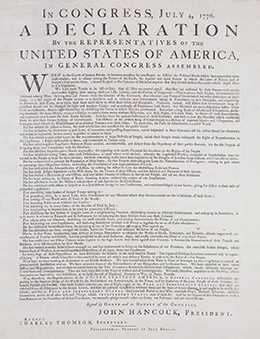| << Chapter < Page | Chapter >> Page > |

The preamble to the Declaration began with a statement of Enlightenment principles about universal human rights and values: “We hold these Truths to be self-evident, that all Men are created equal, that they are endowed by their Creator with certain unalienable Rights, that among these are Life, Liberty, and the pursuit of Happiness—That to secure these Rights, Governments are instituted among Men, deriving their just Powers from the Consent of the Governed, that whenever any Form of Government becomes destructive of these Ends, it is the Right of the People to alter or abolish it.” In addition to this statement of principles, the document served another purpose: Patriot leaders sent copies to France and Spain in hopes of winning their support and aid in the contest against Great Britain. They understood how important foreign recognition and aid would be to the creation of a new and independent nation.
The Declaration of Independence has since had a global impact, serving as the basis for many subsequent movements to gain independence from other colonial powers. It is part of America’s civil religion, and thousands of people each year make pilgrimages to see the original document in Washington, DC.
The Declaration also reveals a fundamental contradiction of the American Revolution: the conflict between the existence of slavery and the idea that “all men are created equal.” One-fifth of the population in 1776 was enslaved, and at the time he drafted the Declaration, Jefferson himself owned more than one hundred slaves. Further, the Declaration framed equality as existing only among white men; women and nonwhites were entirely left out of a document that referred to native peoples as “merciless Indian savages” who indiscriminately killed men, women, and children. Nonetheless, the promise of equality for all planted the seeds for future struggles waged by slaves, women, and many others to bring about its full realization. Much of American history is the story of the slow realization of the promise of equality expressed in the Declaration of Independence.
Visit Digital History to view “The Female Combatants.” In this 1776 engraving by an anonymous artist, Great Britain is depicted on the left as a staid, stern matron, while America, on the right, is shown as a half-dressed American Indian. Why do you think the artist depicted the two opposing sides this way?
Until Parliament passed the Coercive Acts in 1774, most colonists still thought of themselves as proud subjects of the strong British Empire. However, the Coercive (or Intolerable) Acts, which Parliament enacted to punish Massachusetts for failing to pay for the destruction of the tea, convinced many colonists that Great Britain was indeed threatening to stifle their liberty. In Massachusetts and other New England colonies, militias like the minutemen prepared for war by stockpiling weapons and ammunition. After the first loss of life at the battles of Lexington and Concord in April 1775, skirmishes continued throughout the colonies. When Congress met in Philadelphia in July 1776, its members signed the Declaration of Independence, officially breaking ties with Great Britain and declaring their intention to be self-governing.

Notification Switch
Would you like to follow the 'U.s. history' conversation and receive update notifications?